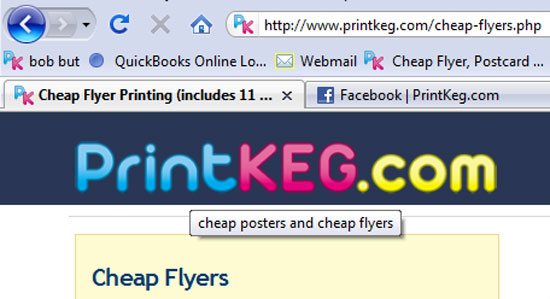
SEO (Search Engine Optimization) should be play an essential role in any real web promotion strategy. However, don’t go overboard with it. The major search engines are quite sophisticated and use numerous methods of determining ranking scores. However, if you don’t optimize, the search engines may have a tough time understanding what keywords are relevant to your website. (unless you have mad incoming links)
20. Get organized – Each of your products or services should have a page that targets certain keywords, but don’t attack this blindly. This will lead to keyword stuffing and a disorganized website. As a cheap printing company, we have separate pages that target “cheap poster printing” or “cheap flyer printing” because our overall business is related to “cheap printing” but we have separate products like “posters” and “flyers.” We don’t have a single page that only targets “cheap printing” since that is not specific enough. Some people ask us why we didn’t select “inexpensive poster printing” because “inexpensive’ has a less degrading connotation. The answer is clear: it isn’t what people are searching. Check what people are searching for.
21. Each page of your website should target different keywords. On every page, you should consider the following items in your HTML.
22. Title tags – Utilize title tags on each page. Keep your title tags clean, short and concise. No keyword stuffing. Each web page should be different. More and more companies are using their title tags effectively.
23. Your keyword should be in at least every other paragraph. – There are certain densities, but don’t worry about all that.
24. Italics Tags– One time per page for each keyword.
25. Bold Tags – One time per page.
26. Header tags – Your keyword for each page should be in an h1 tag.
27. Meta Description Tag – Even nowadays, you should not ignore the description tag. Your keyword should be in the meta description tag least once and no more than twice. Keep the description short and sweet.
28. No Meta Keywords – Don’t bother. But if you decide to, only one to three keywords. Smaller engines may still use this tag, but the main engine pretty much ignore this tag most likely due to webmaster or SEO company abuse.
29. Clean Code – Yes, we already mentioned clean code in Part 2, but it is an integral aspect of optimization. If you are using jumbled and cluttered code, it could lead to spiders not…uh spidering…your site completely.
30. Validated Code – If your website is validated, then the spiders can probably crawl it well, and the code is probably clean too. I mentioned this in Part 2 as well, but it is also an essential step in optimization. Not all search engine optimizers will agree with this, but why not strive to implement proper coding techniques?
31. Easy-To-Follow Links – The pages on your website should have links like “cheap-poster-printing.html” not “results.php?id=12.” This is very important. The link should also match the main or “optimized” keyword for that page.
32. Don’t overdue it – Don’t underestimate the power of optimization, but don’t overestimate it either. Good content is way more powerful than optimization. Your content is likely to be keyword rich.
33. Alt tags – Images have alt tags that are used to explain what the picture is. Put your keyword in one or two of these on the page while still using the tag for its original purpose. Do not jam keywords. Keyword jamming is an old technique that I see much less of these days.
34. Link Title tags – Besides the aforementioned title tag, links and images can also have title tags. Be sure you use them in your main links and images using your keyword.
35. Careful with the Javascript – long scripts can tire out search engine spiders and exhaust browsers.
36. Less Flash – Flash has always been an issue concerning SEO, and it has gotten better, but I still stay away from it. Think more HTML5 and CSS. This is debatable by many. Just ask Steve Jobs at Apple what he thinks. Not that this has anything to do with SEO…or does it? Also note that Google has embraced Adobe Flash with its Android operating system.
37. SEO is forever – You should improve or add pages to your site on a continuous basis. You will probably not initially create a super optimized website that rakes in traffic at launch.
38. Submit to DMOZ – Be sure to submit your website to the ODP (open directory project.) It may take quite a few submissions. In fact, as of 10/20/2010, PrintKEG has yet to be added to DMOZ despite two submittals.
39. No Frames or I-Frames – Stay away because they are not crawled by search engine spiders.
40. 100 Link Rule – Stay under 100 links on any one page. Anything over 100 is most likely not crawled from that page. I try to say under 50.
41. HTML Sitemap – Be sure that you have a nice sitemap that is useful to customers. Its basically an index of your website. First, it helps users find the information they are looking for and it helps search engine spiders find all of your pages.
42. 404 Page – Be sure to put a site map on your 404 page.
43. Optimized Incoming Links – If another website links to you, ask them to use your keyword rather than your business name.
44. Optimized Outgoing Links – Link to another site if it is relevant to your post or page but be somewhat stingy and make sure the link is optimized with a title tag.
45. Keyword in your paragraphs – Almost forgot, your keyword should be included once in your first and second paragraph. I don’t always do this, but I am mindful while creating content.
There is more SEO, but I think you’ll be ahead of the game if you follow the aforementioned optimization techniques on each page of your website.

